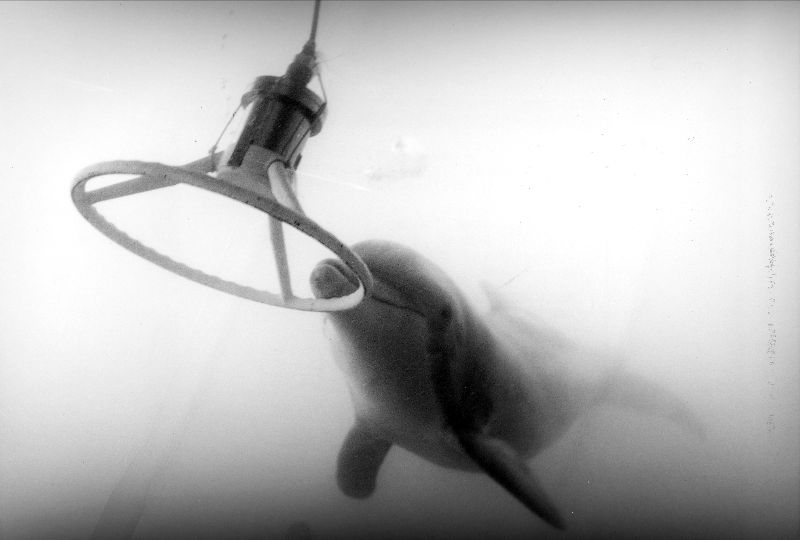How to Get Supplies to an Underwater Laboratory
Here’s a pretty basic rule of the oceans: things either sink or float. If you have a ship or really, anything that fails to float, sooner or later, it’s going to make its way to the ocean floor. And once something is down there, it’s really hard to us humans to reclaim. We can’t breathe underwater without bringing oxygen tanks with us (which is cumbersome) and as you go deeper and deeper, the atmospheric pressure increases rapidly.
But for good reason, we’ve wanted to go down to the ocean’s floor, and therefore, we’ve needed to better understand how humans handle such an environment. In the 1960s, the United States Navy created a program called Sealab (actually “SEALAB” but I think that looks funny) to measure those effects. Engineers built an underwater habitat — basically, a big tube — dropped it off the coast, and sent some divers there to live for a few weeks. The first Sealab was near Bermuda, but that experiment only lasted 11 days due to a tropical storm, and the third Sealab never housed any inhabitants due to engineering flaws (perhaps due to sabotage) in the habitat. But the second one — Sealab II — went off without a hitch. For 45 days, three teams of divers spent two weeks each in a metal container off the California coasts during the late summer and early fall of 1965.
Like any experiment dealing with extreme isolation, though, the people in the habitat weren’t the only members critical to the success of the project. Things break, and you can’t expect a small team of scuba divers to know how to fix everything themselves, so the people back on the surface needed to guide repairs remotely. That hat meant getting new tools to the divers, which could be done pretty easily — you just send another diver down with a bag of stuff. But the Navy didn’t want to waste highly skilled divers on delivery tasks, so they looked for another option. What they found was Tuffy, pictured below.

As you can see, Tuffy was a dolphin. That’s him practicing an exercise of some sort, via the U.S. Naval Undersea Museum’s website.
The idea for using dolphins to aid naval exercises dates back to at least the early 1960s when, according to Ripley’s, “American engineers captured a Pacific white-sided dolphin in hopes of studying the animal and improving their torpedo designs.” That didn’t pay dividends but as Ripley’s notes, “researchers were impressed with the animal’s intelligence and trainability.” The abbreviated Sealab I experiment showed that the surface team needed a way to bring messages to the crew down below, and that the crew living in the habitat was going to need stuff from the surface. This seemed like an excellent opportunity to test the efficacy of using a dolphin to be a delivery mammal. So for Sealab II, the Navy decided to train Tuffy to do just that. And it worked. Throughout the course of the 45-day experiment, Tuffy shuttled messages, tools, and other supplies from the shore to those below with speed and precision.
Unfortunately, efforts to train Tuffy to do more complicated tasks — they hoped he could reliably locate and even rescue lost divers — were not as successful. Tuffy showed a lot of intelligence and the ability to be trained, but he could not consistently accomplish these tasks. Nevertheless, the Navy was impressed with their new aquatic friend; it formed the Navy Marine Mammal Program, and according to the Undersea Museum, Tuffy was “the program’s star pupil in the 1960s, proving dolphins could learn complicated tasks.”
After the Sealab missions were complete, though, the Marine Mammal Program disappeared from the public eye. It wasn’t shut down — it was classified. Per Ripley’s, “not much is known about the program in the ensuing decades, but training bases were set up in San Diego and Hawaii. After pushes for transparency in the 1990s, some details about the program’s activities were revealed. By this time, a reported 140 animals were enrolled in the program.” And it still exists today, in large part due to Tuffy’s successes as an underwater postal worker.
Bonus fact: Dolphins were supposed to be part of another ship’s crew: the U.S.S. Enterprise NCC-1701-D. Yes, that’s the spaceship from Star Trek: The Next Generation. As Screen Rant explains, “the 1991 Enterprise technical manual referenced a ‘Cetacean Navigation Lab,’ as well as an ops room, and lifeboats for the creatures in case of emergency. The manual specifies that 12 bottlenose dolphins were aboard the Enterprise along with a pair of [whales] who ‘supervised’ the other animals.” (If you’re familiar with Star Trek IV: The Voyage Home, you’ll know why this makes canonical sense.) The production crew wanted to show the dolphins as members of the crew, but budgets didn’t allow for any such sea creatures to make it onto the TV show.
From the Archives: Sleeping and Breathing: Dolphins breathe air from above the ocean’s surface, but they sleep underwater. How does that work?
